The Twelve Labors of Hercules is a series of tasks or challenges that the legendary hero Hercules (also known as Heracles) had to perform as a penance for killing his wife and children in a fit of madness induced by the goddess Hera. Completing these labors was intended to redeem him and cleanse his soul.
Find out how the Greek hero Hercules was forced to complete twelve arduous labors to atone for a previous terrible sin.
What Are The Twelve Labors Of Hercules?
Hercules, the Greek hero renowned for his strength and bravery, was born of a woman named Alcmene. The Greek god Zeus, who was Hercules’ father, seduced her. The wife of Zeus – Hera – jealous of her husband’s philandering, vowed to have Hercules killed. Shortly after the Greek hero was born, she ordered two deadly snakes to kill him. Hercules woke from his crib and strangled the two menaces with his bare hands; such was his strength, even as a baby.
In adulthood, Hercules was sent to the mountains near Thebes to work as a shepherd. The King of Thebes, impressed at how the young man rid the area of wild, vicious animals, offered his daughter’s hand in marriage. The strongman accepted, but tragedy lay just around the corner.
Also Read
Hera still wished him dead and had devised a wicked plan. She cast a spell that caused Hercules to lose his mind. In a senseless rage, he killed his two young children. He couldn’t believe what he had just done when he came around.
To find out how he could atone for his grievous sin, he consulted the oracle at Delphi (through which Apollo was contacted). There he was told he must serve scrawny King Eurystheus as a slave for ten years.
Initially, the king was to set him one task a year, but our hero performed twelve, which became known as The Twelve Labors Of Hercules. The specific order of the laborers can vary depending on the source, but the following list presents a commonly accepted sequence:
1. The Nemean Lion
The King set what he thought were impossible tasks; such was his jealousy of Hercules’ strength. First, he ordered Hercules to fetch him the skin of a strong lion that hunted in Nemea. Undaunted, Hercules set off and arrived at the village of Cleonae forthwith. There he stayed at the house of Molorchus, a poor man. The beggar didn’t rate Hercules’ chances, and so offered to sacrifice one of his animals for good luck. Boldly, Hercules requested that he wait for thirty days and, if he had not returned, sacrifice the animal in honor of him. If he were successful, they would make the sacrifice to Zeus in recognition of his help.
Having tracked down the lion, the warrior loosed arrows from his bow. It was apparent that they were useless against the thick hide of his enemy, which had fled to some nearby caves. The caves had two entrances, so Hercules pushed a huge boulder over one and entered the other. The lion was trapped. Hercules tackled it with his bare hands and choked it. Victorious, he returned to the beggar with the lion over his shoulder. After sacrificing to Zeus, the hero returned to Mycenae, where the king awaited news of his death.
Eurystheus was so amazed that Hercules had managed to kill the lion that he hid in a bronze well and would only communicate from afar.
2. The Lernean Hydra

The nine-headed, poison-tongued Hydra that terrorized the countryside near Lema was Hercules’s next foe. To complicate matters, one of the nine heads was immortal. The fighter took his nephew Iolaus with him. They encountered the Hydra by the springs of Amymone and drove it from its lair by unleashing a torrent of flaming arrows at it. After grabbing it, Hercules thrashed at its head. Each time he chopped one off, though, another would appear. He called on his nephew to hold a burning torch to the neck of the head he had just removed. This way, they gradually depleted the Hydra’s energy. After decapitating the immortal head, Hercules buried it deep into the earth. Lastly, he dipped his arrows in the poisonous blood of the beast and returned to Mycenae.
The king was not impressed, though. He ruled that it did not count as labor because Iolaus had aided him.
3. The Hind Of Ceryneia
One might have thought that the third labor, to bring the female deer of Ceryneia to the king, would be ridiculously easy. However, the deer was sacred to Diana, Goddess of Hunting and The Moon. It had golden horns and bronze hooves and was a fleet of feet. If Hercules harmed the deer, he would surely face the wrath of Diana!
He tracked the deer for one year and became impatient. When the hind rested near Mount Artemisius, Hercules feared she might get away, so he shot her with an arrow. With the dying deer over his shoulders, he set off home but was immediately confronted by Diana and Apollo. Diana was furious and about to punish Hercules when he told her his story. She took pity on him, healed the deer, and let him carry it back alive.
4. The Erymanthian Boar
The King told Hercules that he must bring the boar that lived on Mount Erymanthus back to him alive. It came down into the valleys, attacking farmers and their livestock. On his way to the mountains, Hercules encountered Pholus, the centaur, who cooked him a meal to give him strength for the rest of his journey. Seeing a pot of wine, the warrior asked if he might drink some. Pholus warned him that it also belonged to the rest of the centaurs and that they might not be happy. Hercules opened the pot anyway. The other centaurs smelt the wine a short distance away and rushed to investigate. They attacked the hero, but he chased them away and shot several of them with his arrows (poisoned with the blood of the Hydra). Pholus accidentally stabbed himself with an arrow and was also killed. After burying the kindly centaur, Hercules set off after the boar.
The boar was quite an easy conquest compared with previous laborers. It became afraid and hid in the bush. Hercules trapped it in a net and carried it back to the king.
5. The Augean Stables
For his next labor, Hercules was ordered to clean the stables of King Augeas. Powerful and wealthy, the king had masses and masses of cattle. He was so impressed with Hercules’s offer (having not been told about the involvement of Eurystheus) that he offered to give him a tenth of all his livestock if he succeeded.
First, Hercules ripped holes in the stable walls at either end. Then he dug two massive trenches to nearby rivers, diverting their flow into the huge stables. The water then drained from the hole in the far stable wall. Augeas was about to pay Hercules when he heard that Eurystheus had tasked him. Thus he refused payment.
Fortunately, Augeas’ son had watched the feat and testified favorably for Hercules before a judge. The King was forced to pay up. However, upon returning to Mycenae, Eurystheus declared that it had not counted as labor because Hercules had been paid for it.
6. The Stymphalian Birds
For Hercules’s sixth labor, King Eurystheus demanded he drives away a large flock of man-eating birds from a lake near Stymphalos. The hero traveled to the lake and saw the birds in the trees but was at a loss as to how to disturb them.
Suddenly, the goddess Athena appeared and handed him a pair of bronze koalas made by the god of the forge Hephaistos, which made a terrific noise. Using these, he forced the birds away from the trees and shot them with his arrows.
7. The Cretan Bull
The sea god Poseidon had sent King Minos of Crete a bull as a gift, which the king had promised to sacrifice in tribute to him. When he saw the bull, though, he decided it was too fine an animal to kill and slaughtered a different one instead.
When Poseidon found out, he was very angry and made the bull run through the kingdom, causing terror wherever it went. Also, he made Minos’ wife fall in love with the animal, and she later gave birth to the Minotaur (a tale in itself!).
Hercules was required to retrieve the bull for his master. When he found it, he easily wrestled it to the floor and then drove it back to the waiting Eurystheus. In his stupidity, the king let it go, and it wandered the area for several years, creating havoc amongst the locals.
8. The Man-eating Horses of Diomedes
For this labor, Hercules traveled with a band of volunteers to the land of Bistonia, of which Diomedes was king. Upon reaching their goal, the band quickly overpowered the grooms and encouraged the horses toward the waiting boat.
As they were leaving, Diomedes and a host of soldiers gave chase. Hercules turned to confront them, leaving the horses with a man named Abderos. The Bistonians were no match for the powerful Hercules, and after he had killed their king, the rest fled. Returning to the horses, the warrior found that they had eaten Abderos. He quickly herded them onto the boat and returned to Mycenae.
Again, the foolish king let them go, and again they caused terror before perishing near Mount Olympus.
9. Hippolyte’s Belt
Hippolyte, queen of the Amazons, had been given a belt by Ares, the God of War. Eurystheus had heard of it and wished it as a present for his daughter. Hercules was accompanied by a band of volunteers and traveled by boat to his destination once more.
Upon reaching land, the group soon encountered the Amazonian queen, who asked what they wanted. Hercules told her the truth, and taking pity on him; she said he could have the belt. However, Hera, disguised as an Amazon, made the rest of the tribe believe Hercules would kidnap their queen. Suddenly they attacked, and there was a huge battle. In it, Hippolyte was killed by Hercules, who managed to return to the ship and Mycenae.
10. The Cattle Of Geryon
To complete his tenth labor, Hercules had to travel to the end of the known world and confront the monster Geryon. The beast was the son of Chrysaor, who sprung from the body of the dying Medusa with Pegasus, and Callirrhoe, the daughter of two titans. It was a fearsome beast with three heads and three sets of legs. Hercules was required to wrest Geryon’s cattle from him.
To complicate matters, the cattle were guarded by Orthus, a two-headed hound, brother of Cerberus (see Labor twelve), and the herdsman Eurytion.
On his way to the island of Erythia, where the cattle lived, Hercules fought many battles and allegedly split a mountain in half (the legacy of this feat in the modern world is the Strait of Gibraltar).
Finding the cattle, he disposed of the guards by clubbing them to death. Geryon attacked him but was killed by Hercules’ poison arrows (covered in the blood of the Hydra).
Returning home, Hercules was ambushed by two sons of Poseidon, who tried to steal the cattle. The mighty soldier killed them for their audacity. In the aftermath, one of the cattle fled to Italy, where it came under the ownership of a king. The king decided Hercules could have the creature back only if he could beat him in a wrestle. Unsurprisingly, our hero won, killed the king, and returned the bull to the herd. Finally, Hera sent flies to attack the cattle, forcing Hercules to regroup them before returning to the waiting Eurystheus. The king sacrificed the cattle.
11. The Apples Of The Hesperides
Far to the north of Greece, in a garden, these apples were guarded by a hundred-headed dragon and the Hesperides (nymphs who were daughters of Atlas). Hercules searched for the garden but to no avail.
On his travels, he fought several powerful beings. Kyknos, the son of Ares, was soon overpowered. The sea god Nereus told him where to find the garden after their battle. Then he encountered Antaeus (a son of Poseidon), who he crushed.
He was less lucky against another son of Poseidon, Busiris, who captured him and planned to kill him. Hercules escaped, though.
Eventually, he arrived at the rock on Mount Caucasus, where Prometheus was chained as a punishment for ridiculing the gods. Each day an eagle would peck at his liver, but the next day the organ would grow back, only for it to happen again. Hercules killed the eagle, and Prometheus advised him to send Atlas for the apples as a reward.
Hercules found Atlas and was forced to hold up the world and the sky for the Titan while he was gone. Upon his return, Hercules tricked him into holding up the earth again and returned to Mycenae with the apples. Subsequently, they were returned to the Gods.
12. Cerberus Of Hades
The final labor is considered to be the most dangerous of all. Hercules had to travel to the Underworld and kidnap Cerberus, a vicious beast with three dog heads, a dragon’s tail, and a mass of snakes covering its back. Its task was to prevent the living from entering the world of the dead.
Hercules realized the dangers, so beforehand went to visit the priest Eumolpus, who blessed him. He entered the Underworld through a cave at Taenarum in Laconia. Eventually, he encountered Pluto (the god of the Underworld) and asked if he could take Cerberus. Pluto agreed, as long as Hercules overpowered the monster with sheer brute strength.
Continuing, the warrior found Cerberus near the Gates of Acheron. He grabbed the creature in a great bear hug and forced it into submission. Jubilant, he then took it back to the astounded King Eurystheus.
Hercules had atoned for his sins as a young man and no longer had to serve the dubious King Eurystheus. Through his deeds, he became one of the greatest Greek Heroes, and in modern English, the word Herculean is used to describe something requiring great strength or effort.
By completing these twelve challenging labors, Hercules demonstrated his superhuman strength, courage, and resourcefulness, solidifying his status as one of the greatest heroes in Greek mythology.






